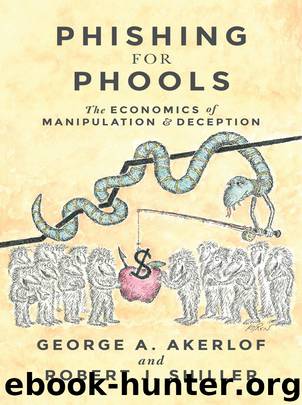Phishing for Phools: The Economics of Manipulation and Deception by George A. Akerlof & Robert J. Shiller

Author:George A. Akerlof & Robert J. Shiller
Language: eng
Format: mobi
Publisher: Princeton University Press
Published: 2015-09-21T14:00:00+00:00
PART THREE
Conclusion and Afterword
CONCLUSION: EXAMPLES AND GENERAL LESSONS
New Story in America and Its Consequences
We began this book in one place, but are now ending it in another. In the beginning, we introduced phishing for phools with examples from what is now traditional behavioral economics: this was Cialdini’s list (in the introduction, on phishing equilibrium). To recall, Cialdini had a list of six specific psychological biases whereby people could be manipulated.
But as our book has progressed, a new emphasis has emerged. That emphasis has given a much more general characterization of the reasons why people are phished. Since the marketing and advertising chapter (chapter 3), we have been saying that people are phishable because the “stories” they tell themselves are an important input into their decisions. Why does this mode of decision making make us so manipulable? Because the typical story meanders; it branches out. Most phishing, in some way or other, consists of grafting new branches onto the old “stories” people are telling themselves; sometimes, it also involves supplanting the old story with a new one.
There is another, equivalent, way to express the same thought. One of the most fundamental human skills is our ability to focus: on some things; not on others. We could have called the “stories” that people tell themselves when they make their decisions their “focus.” This notion makes it immediately obvious why people are phishable, as well as giving us a clue regarding how phishing is accomplished, since manipulation of focus is the basis for two professions. Pickpockets and magicians have special skills at diverting our attention; then they do their sleight of hand.
Before writing the previous paragraph, we reviewed our many examples, from Cinnabon® onward. This check demonstrated that in every one of them, the phish occurred because the phisherman took advantage of the phool’s wrong focus. In some cases the phisherman, like the magician and the pickpocket, himself generated that wrong focus. We also checked Cialdini’s list of psychological biases; each one of them could be considered to be the result of an errant focus by the phool.
Phishing for Phools Itself Is a Story
That takes us to the most fundamental message of Phishing for Phools. We have written this book to offset what we consider to be another wrong focus. There is a story regarding free markets that is widely believed in the United States, and is also influential abroad. This story is derived from an unsophisticated interpretation of standard economics. It says that free-market economies, subject to the caveats of income distribution and externalities, yield the best of all possible worlds. Just let everyone be “free to choose,” says the mantra, and we will have an earthly paradise, as close to the Garden of Eden as our existing technology, our human capabilities, and the distribution of income will allow.
We (the authors) see the cornucopia that free markets have delivered. But just as every coin has two sides, so do free markets. The same human ingenuity that produces the cornucopia also goes into the art of the salesman.
Download
This site does not store any files on its server. We only index and link to content provided by other sites. Please contact the content providers to delete copyright contents if any and email us, we'll remove relevant links or contents immediately.
| Administration & Medicine Economics | Allied Health Professions |
| Basic Sciences | Dentistry |
| History | Medical Informatics |
| Medicine | Nursing |
| Pharmacology | Psychology |
| Research | Veterinary Medicine |
The Art of Thinking Clearly by Rolf Dobelli(9910)
The 5 Love Languages: The Secret to Love That Lasts by Gary Chapman(9277)
Mindhunter: Inside the FBI's Elite Serial Crime Unit by John E. Douglas & Mark Olshaker(8699)
Becoming Supernatural by Dr. Joe Dispenza(7833)
The Road Less Traveled by M. Scott Peck(7278)
Nudge - Improving Decisions about Health, Wealth, and Happiness by Thaler Sunstein(7242)
Mastermind: How to Think Like Sherlock Holmes by Maria Konnikova(6936)
Enlightenment Now: The Case for Reason, Science, Humanism, and Progress by Steven Pinker(6871)
Win Bigly by Scott Adams(6827)
The Way of Zen by Alan W. Watts(6288)
Factfulness: Ten Reasons We're Wrong About the World – and Why Things Are Better Than You Think by Hans Rosling(4487)
The State of Affairs by Esther Perel(4485)
Gerald's Game by Stephen King(4374)
Man's Search for Meaning by Viktor Frankl(4271)
The Confidence Code by Katty Kay(4038)
Thinking in Bets by Annie Duke(3996)
The Worm at the Core by Sheldon Solomon(3325)
Hidden Persuasion: 33 psychological influence techniques in advertising by Marc Andrews & Matthijs van Leeuwen & Rick van Baaren(3292)
Enlightenment Now by Steven Pinker(3271)
